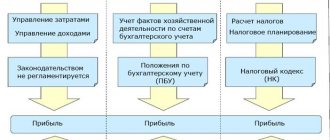The legality of the reorganization of enterprises - legal entities is provided for in Art. 57 Civil Code of the Russian Federation. It is possible to reorganize an enterprise by dividing it, separating it, merging, transforming it and joining it. A combination of these methods is also possible. The law allows the reorganization of two or more companies with different legal forms at the same time. Reorganization involves significant work: submission of accounting and tax reporting in established forms in a short time for the previous organization and for its successor.
Financial statements
During reorganization, the newly formed enterprise undertakes the obligation to submit year-end reporting for its predecessor within three months after the end of the year (Article 23-1(5) of the Tax Code). A copy of the reporting is submitted, in addition to the Federal Tax Service, to the statistics service. The period for which information is included in it: from the beginning of the year until the date preceding the date of state registration of the results of the reorganization.
The assignee also prepares reports for himself – the so-called introductory reports. It is formed from the data transferred by the predecessor on the basis of the transfer deed and adjusted to the amounts of business transactions that took place after its preparation. Typically, the act is drawn up as close as possible to the date of reorganization, and then the data, together with the adjustment amounts as of the registration date, are entered into the balance sheets and transferred to the successor (Federal Law No. 402 of 06-12-11, Articles 16-6,7) . Additions to the act are recorded.
Attention! Public sector organizations are exempt from compiling primary reporting.
The first reports after the reorganization are not submitted to the regulatory authorities: the obligation to submit them arises only at the end of the year.
"Primary" in the transition period
At the transformation stage, organizations are faced with the following problem: contracts with counterparties were signed by the predecessor, and the successor will have to work on them. Does this mean that new agreements or additions to them need to be concluded? Or is it enough to send out information letters indicating the name and details of the new organization?
We believe that such letters are quite sufficient. The fact is that when the organizational and legal form changes, the rights and obligations of the reorganized company are transferred to the newly emerged legal entity under a transfer deed (Clause 5 of Article 58 of the Civil Code of the Russian Federation). This also applies to contractual relationships. It turns out that no additional agreements signed by counterparties are required.
Acts of work performed, invoices and invoices should ideally be written out like this: up to the day of reorganization on behalf of the predecessor, on the date of reorganization and further on on behalf of the successor. But given that after the transformation, the terms of the contracts actually remained the same, it is permissible to begin drawing up a “primary agreement” on behalf of the new organization from the first day of the month in which the reorganization took place. At the same time, in our opinion, the numbering of primary documents can not be interrupted.
Transfer deed
Despite the fact that the transfer deed, as one of the main documents during reorganization, is mentioned in Art. 16-7 Federal Law No. 402, which deals with financial statements during the reorganization of legal entities. persons, its preparation is not mandatory. According to Art. 59-2 and Art. 58 of the Civil Code of the Russian Federation, it is necessary only if the reorganization is carried out in the form of division and separation. Without a transfer deed signed by the parties, in this case there may be a refusal of state registration of the successor enterprise (Article 59-2, paragraph 2). This is stated in the joint letter of the Ministry of Finance with the Federal Tax Service No. GD-4-14 / [email protected] dated 14-03-16.
The transfer act is formed on the principle of compliance with the provisions of Art. 59 (1) Civil Code of the Russian Federation. It contains information about the receivables and payables of the reorganized enterprise, with special emphasis on disputed contracts and obligations under them. In addition, when compiling it, they are guided by Order of the Ministry of Finance No. 44n. The Order contains instructions for the preparation of reports by the accounting service during the period under consideration.
The transfer certificate includes:
- financial statements;
- inventory records (liabilities, property);
- package of primary documentation for accounting areas;
- decryption of debts;
- a document confirming the fact of entry in the Unified State Register of Legal Entities on the formation of legal successors.
Attention! All debtors and creditors of the enterprise must be notified of the reorganization and the fact of notification must be reflected in the transfer deed.
Features of accounting and tax accounting during reorganization in the form of merger
The LLC at OSNO is planning a reorganization in the form of a merger. An LLC will join the simplified tax system. LLC on OSNO is subject to mandatory audit. Should an LLC be audited using the simplified tax system? How to carry out reorganization and reflect transactions in accounting and tax accounting? What to do with the acceptance of LLC expenses for the simplified tax system if the documents are received late? What reporting is required?
Merger is the termination of one or more companies with the transfer of all rights and obligations to another company (clause 2 of article 58 of the Civil Code of the Russian Federation, clause 1 of article 53 of the Federal Law of 02/08/1998 No. 14-FZ “On Limited Liability Companies”).
Since all the rights and obligations of the affiliated organization, in our opinion, are transferred to the acquiring organization. The activities of the affiliated organization, among other things, are subject to audit and tax inspection.
In accordance with paragraph 2 of Article 346.25 of the Tax Code of the Russian Federation, organizations that applied the simplified taxation system (STS), when switching to calculating the tax base for corporate income tax using the accrual method, recognize as expenses the costs of purchasing goods (works, services) during the period of application of the STS , property rights) that were not paid (partially paid) by the taxpayer before the date of transition to calculating the tax base for income tax using the accrual method, unless otherwise provided by Chapter. 25 of the Tax Code of the Russian Federation (letter of the Ministry of Finance of Russia dated January 19, 2012 No. 03-03-06/1/20). Thus, the acquiring organization at the time of merger (or at the time of receipt of late documents) can take into account as part of the expenses taken into account for the purposes of calculating the tax base for income tax, expenses incurred by the affiliated organization that applied the simplified tax system, but not taken into account when calculating the tax base for tax simplified tax system.
A successor organization applying the general taxation regime does not have the right to reduce the income tax base for losses of the merged company that used the simplified tax system before the merger (letter of the Ministry of Finance of Russia dated September 25, 2009 No. 03-03-06/1/617).
Features of the preparation of accounting (financial) statements during the reorganization of a legal entity are determined by the provisions of Article 16 of the Federal Law of December 6, 2011 No. 402-FZ “On Accounting”, hereinafter referred to as Law No. 402-FZ). When reorganizing a legal entity in the form of merger, the last reporting year for a legal entity that merges with another legal entity is the period from January 1 of the year in which an entry was made in the Unified State Register of Legal Entities (USRLE) about the termination of the activities of the merged legal entity, until the date its introduction (clause 2 of article 16 of Law No. 402-FZ).
The basis for the formation of financial statements upon merger are the following documents:
• decisions of the founders on reorganization in the form of merger;
• agreement on accession;
• constituent documents of the organization resulting from the reorganization;
• transfer deed and attachments to it (if necessary).
According to paragraph 3 of the Guidelines for the preparation of financial statements during the reorganization of organizations, approved. Order of the Ministry of Finance of Russia dated May 20, 2003 No. 44n (hereinafter referred to as the Guidelines) for the formation of information in the financial statements when carrying out a reorganization in the documents of merger between the participating parties determines:
• procedure for forming the authorized capital;
• method of assessing transferred (accepted) property and liabilities;
• timing of inventory of property and liabilities;
• the procedure for succession in connection with the implementation of the business activities of the acquired company after the date of drawing up the main transfer act and before the date of entry in the Unified State Register of Legal Entities on the termination of its activities;
• the procedure for the actions of the authorized management bodies of the main and acquired companies within their competence during the reorganization process, including the procedure for interaction with creditors, controlling and registering government bodies, etc.;
• direction (distribution) of the net profit of the reporting period of the acquired company;
• other decisions and activities.
On the day preceding the date of entry into the Unified State Register of Legal Entities on the termination of the activities of the merging companies, the final accounting statements of the merging companies are prepared for the period from the beginning of the reporting year to the date of making the corresponding entry in the Unified State Register of Legal Entities. The final financial statements are prepared in the same manner as the annual financial statements. In this case, the profit and loss account is closed (i.e., the balance sheet is reformed) and the amount of net profit of the acquired company is distributed (directed for certain purposes) on the basis of the agreement on the merger of the founders (clause 9 of the Methodological Instructions).
An explanatory note to the final financial statements of an organization that has ceased to exist may disclose information about the reorganization carried out and the termination of its activities, indicating:
• grounds for reorganization;
• documents transferring property and obligations to the legal successor;
• documents confirming the closure, re-registration of current and other bank accounts by the reorganized organization;
• information on deregistration of the reorganized organization by tax authorities, territorial bodies of the Pension Fund of Russia, regional branches of the Social Insurance Fund of Russia, territorial bodies of the Federal State Statistics Service, etc.
The legal successor does not close the profit and loss account in its financial statements and does not prepare the final financial statements on the day preceding the date of entry into the Unified State Register of Legal Entities of the state registration of the termination of the activities of the acquired organization (clause 21 of the Methodological Instructions).
The financial statements of the successor are formed on the basis of the data of the transfer deed and line-by-line combination (summing or subtracting if there is an uncovered loss of previous years) of the numerical indicators of the final financial statements of the acquiring organization and the numerical indicators of the financial statements of the legal successor (clause 23 of the Methodological Instructions). No accounting entries are generated in this case.
If the financial statements of organizations reorganized in the form of merger include mutual receivables and payables, then the opening balance sheet of the legal successor does not include:
• numerical indicators reflecting mutual receivables and payables, including calculations of dividends;
• financial investments of some reorganized organizations into the authorized capitals of other reorganized organizations;
• other assets and liabilities characterizing mutual settlements of reorganized organizations, including profits and losses as a result of mutual transactions.
The summation of the numerical indicators of the financial results reports (approved by order of the Ministry of Finance of Russia dated July 2, 2010 No. 66n) of the successor and the merging organization for the reporting periods is not performed. After the merger of one company with another, a report on financial results is drawn up by the legal successor based on information about the income and expenses received by it (in the generally established manner) (clause 23 of the Methodological Instructions).
The procedure for fulfilling obligations to pay taxes and fees, as well as penalties and fines during the reorganization of a legal entity is determined by Article 50 of the Tax Code of the Russian Federation:
• the fulfillment of obligations to pay taxes of a reorganized legal entity is assigned to its legal successor, regardless of whether the legal successor knew before the completion of the reorganization the facts and (or) circumstances of non-fulfillment or improper fulfillment of these obligations by the reorganized legal entity. In this case, the successor must pay all penalties due for the obligations transferred to him;
• the successor of the reorganized legal entity is also obliged to pay the due amounts of fines imposed on the organization for committing tax offenses before the completion of its reorganization. The legal successor of a reorganized legal entity, when fulfilling the obligations assigned to it to pay taxes and fees, enjoys all rights and performs all duties in the manner prescribed by the Tax Code of the Russian Federation for taxpayers;
• reorganization of a legal entity does not change the deadlines for the fulfillment of its obligations to pay taxes by the legal successor of this legal entity;
• when one legal entity merges with another legal entity, the legal successor of the merged legal entity in terms of fulfilling the obligation to pay taxes is recognized as the legal entity that merged it.
The Tax Code of the Russian Federation does not establish special deadlines for filing returns for the last tax period upon reorganization (including merger) of an organization.
According to the letter of the Ministry of Finance of Russia dated December 11, 2007 No. 03-02-07/1-477, letters of the Federal Tax Service of Russia dated March 9, 2011 No. KE-4-3 / [email protected] ; dated 07/06/2007 No. 23-3-04/546 and the Federal Tax Service for Moscow dated 03/05/2008 No. 18-11/ [email protected] to report on taxes for which the tax period is set as a year (profit tax, tax when applying simplified tax system, etc.), must be the legal successor. That is, the merging organization receives the responsibility not only to pay taxes, but also to submit tax returns at the end of the year, which the merging enterprise did not submit and is unable to submit, since it no longer exists.
Tax returns submitted for an affiliated organization indicate the TIN and KPP of the successor organization with the OKATO code of the municipality in whose territory the affiliated organization was located. On the title pages of the declarations, the name of the successor organization should be indicated, as well as the name of the affiliated organization (for example, in brackets) for which they are represented (letter of the Federal Tax Service of Russia dated June 19, 2009 No. 3-6-03 / [email protected] ).
According to paragraph 16 of Article 15 of the Federal Law of July 24, 2009 No. 212-FZ “On insurance contributions to the Pension Fund of the Russian Federation, the Social Insurance Fund of the Russian Federation, the Federal Compulsory Medical Insurance Fund”, in the event of reorganization of the organization, payment of insurance contributions, as well as submission of calculations for accrued and paid insurance premiums are carried out by the legal successor.
The 1C:ITS information system is updated every day and contains ready-made advice on accounting, tax and personnel records.
It is quite possible that the answers to the specific practical questions that you are currently looking for are already in the “Auditor Answers” section of the 1C:ITS Information System. And in order not to miss the latest expert consultations and other useful information, you can subscribe to the free newsletter: https://its.1c.ru/news/subscription.php
You can enter into an information technology support agreement with a recommended partner
More about 1C:ITS
Tax reporting
Despite the variety of reorganization options, there are common points when submitting tax reports. They are set out in Art. 55 of the Tax Code of the Russian Federation: the tax period ends with the date of transformation, except for VAT and other taxes with a tax period of “quarter” (“month”). Let's consider the most significant of them.
Income tax
Reporting is submitted based on the data of the tax period from the beginning of the year until the transformation, which means that this responsibility will fall on the accounting service of the legal successor. In practice, the successor is obliged to calculate two declarations: for the predecessor and for himself, without missing the deadline for submitting them. The law requires submitting the declaration no later than March 28 of the following year. Often, the tax office requires reporting to be submitted earlier - within the deadline used for calculating advance payments (by the 28th of the following month).
Property tax
Rent by analogy with income tax. When submitting reports for a predecessor, it is important to remember that it is not data on the advance payment that is provided, but a declaration for the period in which the reorganization took place.
The standard deadline is March 30 next year. As in the situation with income tax, in the case of transformation, the Federal Tax Service often requires submitting a declaration earlier: within the deadlines provided for advance payments, before the 30th day of the month following the reporting period.
VAT
In this case, the tax period is quarterly, and therefore there are peculiarities of filing a declaration during the transformation. It follows from the filling instructions that the predecessor declares his data received before the transformation, and the successor declares his data recorded after the date of reorganization.
However, the Federal Tax Service in letter No. 24-15 / [email protected] dated May 13, 2015 offers an explanation according to which the successor can draw up a single declaration that includes the indicators of both the predecessor and his own. It also contains an option in which the predecessor, having received the consent of the Federal Tax Service in writing, submits the declaration independently and ahead of schedule for himself, before the reorganization is completed with registration. The deadline for filing a declaration is until the 25th day of the month following the reporting period (quarter).
Simplified tax
The rules are identical to those applied to income tax. The declaration includes the period from the beginning of the year until the transformation; it is submitted by the legal successor. The standard deadline is March 31 of the year following the reorganization.
Personal income tax
2-NDFL certificates, according to the law, are submitted before April 1 of the following year (Article 230(2) of the Tax Code of the Russian Federation). Fiscal authorities often require early submission of information from the predecessor, arguing that there is an obligation to do this before the transformation. At the same time, according to the regulatory services, the legal successor submits information for himself, until 1.02. The position is contained in a number of letters and clarifications of the Ministry of Finance and the Federal Tax Service (for example, letter of the Ministry of Finance No. 03-04-06/8-173 dated 19-07-11 ), has obvious legal flaws and can be legally challenged. The legal successor has the opportunity to submit information for himself and for the company existing before the transformation.
Other declarations are submitted similarly, within the time limits established by law: by quarter (month) or by annual indicators. As a standard, the successor prepares two packages of documents: with data for himself and his predecessor. The submission of corrective information is the responsibility of the assignee.
Attention! Declaring indicators to the Federal Tax Service before conversion - “in advance” - can lead to their significant distortion. It is justified only in a situation where economic activity at the predecessor enterprise is not actually carried out until the specified date.
When determining the deadline for submitting information, the transfer of dates to a later date, due to weekends and holidays, is taken into account.
How to prepare reports upon termination of any type of activity
To reflect data on termination of activities, use PBU “Information on discontinued activities” (PBU 16/02).
Such information must be reflected separately in the financial statements. The reporting must indicate:
- description of the discontinued activity;
- the value of the firm's assets and liabilities expected to be disposed of or settled upon termination of operations;
- the amounts of income, expenses, profit (loss) before tax, as well as accrued income tax that relate to discontinued activities;
- inflow and outflow of cash from discontinued operations.
You can provide all this information in the Explanatory Note. However, in PBU 16/02 there is another way: income and expenses can be shown in the Financial Results Statement, and cash flows can be shown in the Cash Flow Statement.
To do this, additional columns should be entered into the required reporting forms - continuing and discontinued activities.
EXAMPLE The main activity of Aktiv LLC is the production of gel pens and inflatable balloons.
On October 25, 2012, the company's board of directors decided to stop producing pens. Until October 30, 2012, all employees involved in the production of pens were notified of dismissal effective February 1, 2012. The estimated amount of severance pay is 4,500 rubles. The amount of the penalty that the company will have to pay to suppliers is 7,000 rubles. By decision of the board of directors, the property that was used in the production of pens must be sold. In November 2012, Aktiv entered into a contract for the sale of 500 kg of remaining unused materials at a price of 350 rubles/kg (excluding VAT). The materials are expected to be handed over to the buyer in March next year. Their actual cost was 380 rubles/kg. Based on these data, Aktiva’s accountant created a reserve to reduce the cost of materials. In addition, a penalty was assessed. To do this, he made the following entries in the accounting: DEBIT 91-2 CREDIT 14 - 15,000 rubles. (500 kg X (380 rub./kg – 350 rub./kg)) – a reserve has been created to reduce the cost of materials; DEBIT 91-2 CREDIT 76 – 7000 rub. – penalties were assessed to suppliers. Revenue from the sale of pens for 2012 amounted to 120,000 rubles. (without VAT). The cost of pens sold is 78,000 rubles. Commercial expenses associated with their sale are 9,000 rubles. In the “Discontinued Operations” column of the Income Statement, you need to show income and expenses associated with the sale of gel pens (revenue from their sale, cost, business expenses for their sale, etc.). The amount of the reserve for impairment of material assets and the cost of paying the penalty are reflected in line 2350 “Other expenses” of the Statement of Financial Results. For comparability of the Report data, indicators related to the sale of pens are indicated here not only for the reporting year, but also for the previous year. The financial results report for 2012 can be formatted, for example, like this:
| Indicator name | Continuing activities | Discontinued operations | Organization as a whole | |||
| for 2012 | for 2011 | for 2012 | for 2011 | for 2012 | for 2011 | |
| Income and expenses from ordinary activities Revenue | 580 | 380 | 120 | 160 | 700 | 540 |
| Cost of sales | (340) | (197) | (78) | 103 | (418) | (300) |
| Gross profit (loss) | (20) | (17) | (9) | (15) | (29) | (32) |
| Administrative expenses | — | — | — | — | — | — |
| Profit (loss) from sales | 220 | 166 | 33 | 42 | 253 | 208 |
| Other income and expenses | ||||||
| other expenses | (2) | (15) | (2) | (20) | (4) | (35) |
The cash flow statement must be completed in a similar manner. It separately indicates data on continuing and discontinued activities, as well as on the company as a whole.
Main
- When reorganizing enterprises in any form, primary responsibility for submitting any reports falls on the legal successor of the reorganized enterprise.
- The reporting deadlines are the same for all business entities.
- During the reorganization, it is customary to draw up an act of transfer of documentation belonging to the reorganized enterprise. If the reorganization is carried out in the form of division and separation, drawing up an act is mandatory. Without this document, state registration may be refused and the reorganization will not be completed legally.
Typical mistakes during reorganization
Mistake #1. Accounting during reorganization in the form of separating the difference between the amount of the value of property rights contributed as payment for property and the nominal value of the received shares, shares or shares as profit/loss.
For accounting purposes, the difference between these indicators is not recognized as profit or loss of the legal entity.
Mistake #2. Failure to reflect business transactions in the period of time between the preparation of the separation balance sheet for the purpose of reorganization and the date of making the corresponding entry in the Unified Register.
It is the responsibility of the reorganized company to reflect all business transactions in a given period of time, since legal entities participating in the reorganization are required to know about the changes that have occurred in the enterprise.












